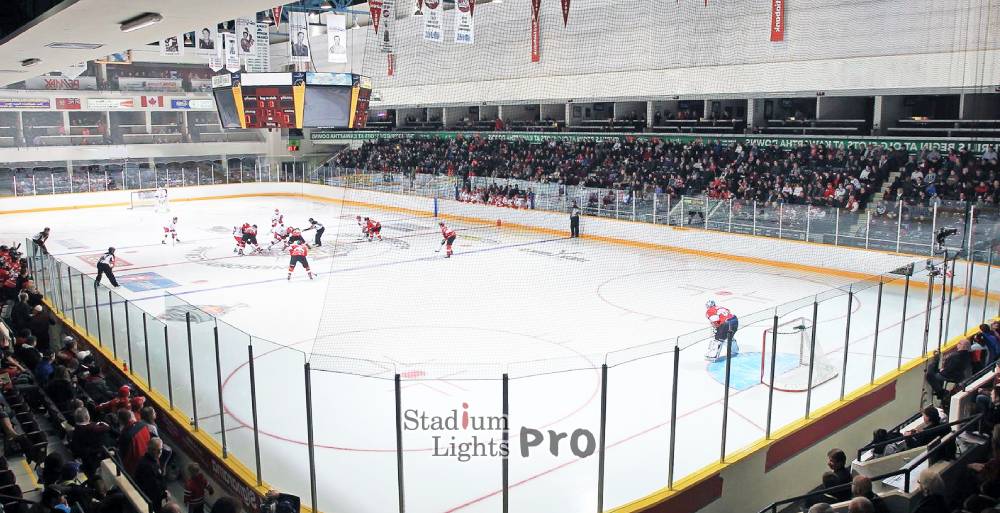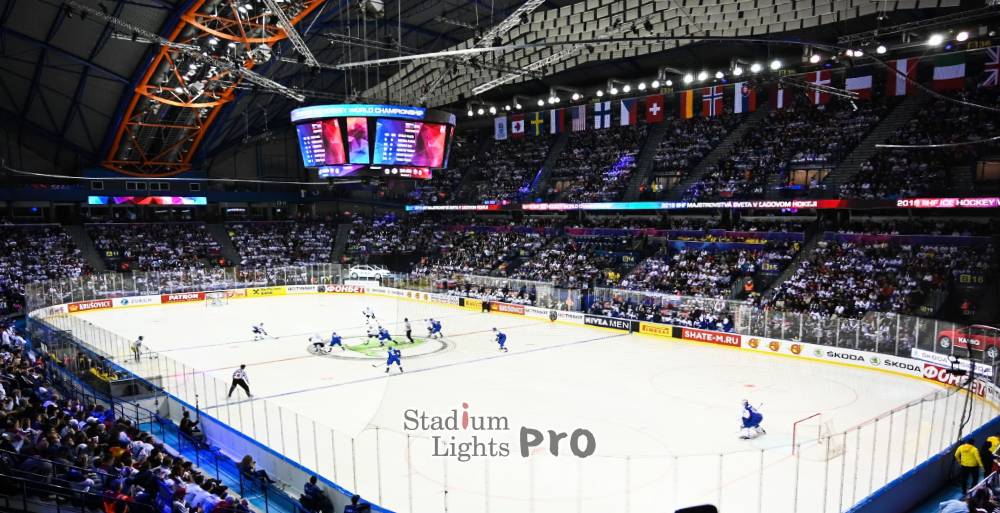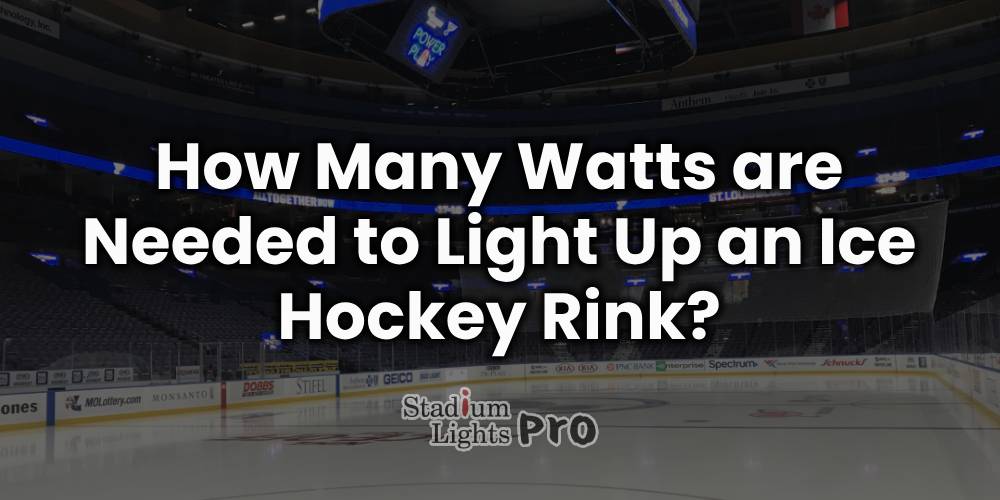Lighting up an ice hockey rink requires careful planning to ensure visibility, player safety, and an optimal experience for spectators. The wattage required for proper rink lighting is influenced by multiple factors such as the size of the rink, the height of the lights, the type of lighting system used, and the specific needs of the event. Understanding the wattage needed for an ice hockey rink is essential for anyone involved in building, upgrading, or maintaining such facilities.
Table of Contents
ToggleUnderstanding Lighting Technologies

Not all lighting systems are created equal. The technology used for rink lighting can significantly impact the wattage required to achieve the desired illumination. Different types of lights offer varying efficiencies and brightness levels, which can influence the overall power consumption.
Traditional Lighting Systems
Traditional lighting systems, such as incandescent or halogen lights, were once common in ice hockey rinks. While these systems provide a warm light, they are not as energy-efficient as modern options. For instance, incandescent bulbs typically consume more wattage to produce a similar amount of light when compared to newer technologies.
LED Lighting Systems
LED lighting has gained popularity in recent years due to its energy efficiency and ability to provide high-quality illumination. LEDs use much less wattage than traditional bulbs while delivering brighter, more consistent lighting. They also produce less heat, making them an ideal choice for rinks where temperature control is important. Rinks utilizing LED systems may require fewer watts to achieve optimal lighting levels, resulting in lower energy consumption and reduced operational costs.
Power Requirements for Professional Ice Hockey Rinks
| Category | Professional Rinks (e.g., NHL) | Recreational Rinks |
|---|---|---|
| Typical Rink Size | 200 ft x 85 ft (17,000 sq ft) | 185 ft x 80 ft (14,800 sq ft) |
| Lighting Levels (Lux) | 1500 – 2000 lux | 500 – 1000 lux |
| Mounting Height | 40 – 60 feet | 20 – 30 feet |
| Fixture Count | 80 – 100+ | 30 – 50 |
| Wattage per Fixture (Traditional) | 1000 – 1500 watts | 1000 watts |
| Total Wattage (Traditional) | 100,000 – 200,000 watts | 30,000 – 50,000 watts |
| Wattage per Fixture (LED) | 400 – 800 watts | 400 – 600 watts |
| Total Wattage (LED) | 40,000 – 80,000 watts | 12,000 – 30,000 watts |
| Lighting Uniformity Ratio | 1.5:1 or better | Less strict, varies |
| Vertical Illumination | ~1000 lux | Lower, not standardized |
| Operating Hours per Day | 12 – 16 hours | 6 – 8 hours |
| Redundancy Systems | Often included (adds standby wattage) | Rarely used |
| Energy Control Features | Advanced (scene managers, dimmers, smart networks) | Basic (zone control, motion sensors) |
Professional ice hockey rinks, such as those used in the NHL, require comprehensive lighting systems that meet the high demands of televised sports, live spectators, and precision gameplay. These venues operate under performance-driven standards, where lighting affects everything from athlete safety to broadcast quality. Unlike recreational rinks, professional setups must deliver consistently high lux levels, avoid flicker, and maintain sharp color rendering to support high-definition television cameras and live-action replays.
Lighting design in these environments is not just about wattage alone but also about how that wattage is converted into effective illumination. Higher wattage may be used inefficiently with older fixtures, while modern LED systems can achieve better results with fewer watts. Still, in many large arenas, overall system wattage remains high due to the sheer size and expectations of the facility.
Wattage Calculation for Large Rinks
A standard NHL-sized ice rink measures approximately 200 feet by 85 feet, totaling 17,000 square feet. To meet league recommendations and broadcast standards, lighting levels of around 1500 to 2000 lux are typically required on the playing surface. Achieving these levels consistently across the rink involves a detailed design that takes into account beam angles, mounting heights, fixture types, and energy conversion efficiency.
In older systems that still use metal halide or similar fixtures, each unit may consume around 1000 watts. A typical setup might require 80 to 100 fixtures, resulting in a total system wattage of 100,000 to 120,000 watts. In rinks that use higher-end equipment or broader coverage, the total could reach up to 200,000 watts. For example, a configuration with 100 metal halide fixtures at 1500 watts each would consume 150,000 watts, not including controls or standby power for redundancy systems.
LED retrofits, by contrast, can deliver comparable light output using fixtures in the 400 to 800-watt range. A modern LED setup with 100 fixtures rated at 600 watts each would draw 60,000 watts while still achieving or exceeding previous lux values. This represents a dramatic reduction in energy use, often by 30% to 60%, without compromising on visibility or uniformity.
For NHL games, lighting uniformity is just as vital as brightness. The uniformity ratio (average-to-minimum lux) typically needs to stay within 1.5:1 to ensure consistent exposure across TV camera angles. High-power lighting must also meet specific criteria for vertical illumination, usually around 1000 lux on vertical planes, to illuminate players’ faces and jersey numbers effectively for viewers and referees alike.
Another consideration is redundancy. Many professional rinks use dual-lighting circuits or backup systems to prevent total darkness during outages. This can result in standby wattage consumption of several thousand watts more, even when not in active use. Additional energy may also be consumed by advanced lighting control systems, dimmers, networked scene managers, and heat dissipation technologies integrated into some high-output fixtures.

Lighting for Smaller or Recreational Rinks
Smaller or community ice rinks typically operate at lower light levels, ranging from 500 to 1000 lux, depending on whether they serve casual skating, local leagues, or amateur competitions. These venues usually prioritize energy savings and simplicity over high-performance broadcast quality. Consequently, their lighting systems are scaled to fit these needs without the same extensive infrastructure.
For example, a community rink measuring 185 feet by 80 feet (14,800 square feet) may operate with only 30 to 50 light fixtures. Each fixture may range from 400 to 600 watts if using LED systems, totaling between 12,000 and 30,000 watts. With older metal halide or high-pressure sodium fixtures rated at 1000 watts each, the same rink could easily consume 30,000 to 50,000 watts or more to meet basic visibility standards.
Although recreational rinks do not need to meet broadcast lux levels, even light distribution and glare control remain top priorities for player visibility and safety. Designers often use software tools to model beam spread and light overlap to avoid hot spots and dark zones. Mounting heights in these facilities are generally lower—ranging from 20 to 30 feet compared to the 40 to 60 feet found in pro arenas—affecting fixture type and wattage requirements accordingly.
Operational hours also impact the total power demand. Professional rinks may run lighting systems for events, practice, and broadcast setups 12 to 16 hours daily, while recreational rinks may operate lighting for only 6 to 8 hours a day. Over time, this difference has major implications for total energy expenditure and fixture lifespan.
Many smaller facilities have moved toward smart lighting systems with motion sensors, zone control, and scheduling capabilities. These systems allow operators to dim or shut off lights in unused zones, conserving power and extending bulb life. When integrated with energy monitoring systems, these upgrades help reduce consumption while ensuring visibility for players and spectators.
Factors Affecting Lighting Requirements for an Ice Hockey Rink

The wattage required for lighting an ice hockey rink is not a one-size-fits-all calculation. Multiple variables affect the amount of light needed. These variables range from the size of the rink to the brightness levels desired. Other influencing elements include the height of the mounting structures, the reflectivity of surrounding surfaces, the age and condition of the lighting system, and the facility’s operational needs. The more thoroughly these aspects are analyzed, the more accurate the wattage estimations become for delivering effective lighting coverage across the rink surface.
Lighting designers and facility managers often rely on advanced photometric analysis to determine how different lighting layouts and wattage values perform under real-world conditions. Without a precise understanding of these influencing variables, rinks may end up over- or under-illuminated, which can lead to either wasted energy or compromised playability. Properly evaluating these factors helps avoid both scenarios, resulting in optimal visual conditions for athletes, spectators, and broadcast cameras.
The Size of the Rink
 The size of an ice hockey rink plays a significant role in determining how much wattage is needed. Standard ice hockey rinks in North America typically measure 200 feet in length and 85 feet in width, providing a total surface area of 17,000 square feet. International rinks, often used in Olympic competition, are slightly wider—about 100 feet across—yielding a larger surface area and, consequently, a greater lighting demand.
The size of an ice hockey rink plays a significant role in determining how much wattage is needed. Standard ice hockey rinks in North America typically measure 200 feet in length and 85 feet in width, providing a total surface area of 17,000 square feet. International rinks, often used in Olympic competition, are slightly wider—about 100 feet across—yielding a larger surface area and, consequently, a greater lighting demand.
As the surface area increases, the number of lumens required to maintain the same level of brightness rises in proportion. For instance, if a North American rink requires 1000 lux of illumination, it translates to 17 million lumens (1000 lux x 17,000 sq. ft. / 10.76 for square meters). To achieve this level of brightness, the total wattage output must be carefully calculated based on the lumen-per-watt performance of the light fixtures used. A facility using less efficient fixtures will need to consume more watts to generate the same light output.
Moreover, some rinks incorporate additional off-ice areas, such as team benches, penalty boxes, and media zones, all of which need to be adequately lit. This expansion in illuminated area further increases the overall wattage requirements. For large complexes with multiple rinks or practice spaces, total lighting demand multiplies accordingly.
The Height of the Lights
Another major factor to consider is the height at which the lights are installed. In ice hockey arenas, fixtures are often mounted on trusses or catwalks that can range from 30 to 60 feet above the rink floor. The higher the light is mounted, the wider the beam can spread, but this also requires more wattage or better lensing to ensure adequate intensity at ice level. High-mount installations need precision-engineered optics to prevent light from dispersing too broadly and becoming ineffective at its intended target.
In recreational or smaller rinks where the ceiling height may be limited to 20 to 30 feet, lighting can be more focused. At these lower elevations, fewer lumens may be lost to dispersion, but shadows and glare become more prominent issues. Fixtures may need to be tilted or repositioned to improve coverage and avoid dark zones. Additionally, lights closer to the action are more likely to interfere with player visibility or be struck by pucks, requiring protective casings or repositioning.
Wattage calculations must therefore take into account the inverse square law of lighting, where the intensity of light falls off sharply with distance. A fixture mounted twice as high needs to deliver far more initial output to maintain equivalent brightness on the surface below. This physical principle often leads to higher total wattage requirements in professional arenas, where high ceilings are standard.
Lighting specialists often use computational modeling to test multiple mounting height scenarios. By simulating how light behaves at various elevations, designers can optimize fixture count, wattage, and placement. In many cases, fewer high-wattage lights positioned at greater heights provide better coverage than numerous low-mounted, lower-wattage fixtures scattered around the perimeter.
It’s also worth noting that in multi-use arenas, light height and angle may need to accommodate various configurations, such as for concerts or other sports. This further influences fixture selection and energy load planning, as lighting must remain versatile without sacrificing performance on the ice.
Lighting Levels and Uniformity
Lighting an ice hockey rink involves more than just ensuring that the ice is bright enough to see. It demands a lighting strategy that addresses both the quantity of light and the quality of its distribution. Visibility, clarity, and consistency are the cornerstones of a well-lit rink, whether for a community facility or a major televised venue. Lighting must not only reach acceptable brightness levels but also achieve balance across the entire playing surface, minimizing dark zones and glare that could disrupt gameplay or viewing.
Illumination Levels for Ice Hockey
Illumination in a hockey rink is measured in lux, which expresses the amount of light hitting a specific area. The proper lux level depends largely on how the facility is used. For recreational or practice settings, a lighting level in the range of 500 to 1000 lux is often sufficient. These levels allow players to see well and maintain spatial awareness without excessive energy consumption.
However, for competitive environments—especially those designed to host tournaments, league play, or televised events—illumination must be far more intense. In these cases, lighting levels between 1500 and 2000 lux are frequently targeted. This level of brightness ensures that players can perform with confidence, referees can make accurate judgments, and fans—both in the stands and watching on screens—can follow the action in sharp detail. Higher lux levels also reduce motion blur and enhance image quality on high-speed cameras used in modern broadcasts.
Certain parts of the rink, such as face-off circles, goal creases, and neutral zones, may receive dedicated lighting treatments to keep lux levels consistent across these focal points. This becomes particularly relevant when slow-motion replays and goal reviews depend on lighting that reveals every detail with precision.
Uniformity of Light
Uniformity refers to how evenly light is distributed across the rink. A surface that is brightly lit in one area but dim in another not only affects player performance but can also create hazards. Players rely on stable visual input for timing, puck tracking, and spatial orientation. Uneven lighting introduces confusion, especially at high speeds, and can increase the risk of injury or gameplay errors.
To quantify uniformity, lighting designers often use a ratio that compares the average lux level across the surface to the minimum level found in any given spot. A common benchmark for professional hockey rinks is a uniformity ratio of 1.5:1 or better. This means that the brightest spot on the ice should be no more than 1.5 times the intensity of the dimmest. Achieving this balance requires careful placement of fixtures, attention to beam spread, and consideration of how reflective surfaces—like ice—affect light behavior.
Rink architecture also plays a role. Ceiling height, truss configurations, and the presence of hanging scoreboards or structural elements can influence how light reaches the ice. To address these challenges, lighting professionals often use 3D simulation tools to map out lighting scenarios before any equipment is installed. These tools help ensure that every inch of the playing surface is evenly illuminated, even around physical obstructions.
For professional venues, vertical illumination also becomes part of the uniformity calculation. Not only must the ice surface be bright, but the light must reach up to players’ faces, jerseys, and the puck when it leaves the ice. Vertical lux values, especially those aimed at camera angles and sightlines, often need to reach 1000 lux or more to maintain consistent broadcast quality. This vertical component is vital in games where player identification, facial expressions, and puck location are scrutinized in high definition.
Moreover, glare control is an often-overlooked aspect of uniformity. Light fixtures must be positioned and shielded to prevent direct light from shining into the eyes of players, referees, or spectators. Excessive glare can negate the benefits of high lux levels, diminishing overall visibility despite the raw power of the lighting system.
To maintain lighting uniformity over time, especially in facilities that operate for many hours daily, regular maintenance and calibration are necessary. Even LED systems, which are praised for their longevity and low degradation, can lose performance consistency over years of use. Replacing individual fixtures, adjusting angles, and recalibrating system controls are all part of preserving the uniformity that a rink depends on.
Uniformity is as much a design challenge as it is a technical one. Balancing lux levels, positioning fixtures, controlling glare, and considering player movement all factor into how successful a lighting system will be—not only in illuminating the ice but in enhancing the entire hockey experience.
Energy Efficiency and Cost Considerations
While understanding how many watts are needed to light an ice hockey rink is a technical challenge, evaluating how efficiently that energy is used is equally relevant for facility operators. Energy efficiency impacts not only operating budgets but also long-term sustainability, equipment longevity, and environmental impact. Choosing the right lighting technology has become a focal point in modern rink design, with LED systems leading the shift toward smarter, cleaner, and more economical solutions.
Lighting a rink involves continuous power usage for extended hours, often ranging from early morning practices to late-night games. Over time, even a slight improvement in lighting efficiency can translate into measurable financial gains. Facility managers, whether operating a professional arena or a local community rink, are increasingly motivated by both financial and ecological outcomes, aiming to reduce operational expenses without compromising lighting performance.
Operational Cost Reduction
Replacing older lighting technologies like metal halide, fluorescent, or high-pressure sodium fixtures with modern LED systems has proven to be one of the most effective strategies for reducing operational costs. LEDs are known for their high efficacy—producing more lumens per watt—resulting in brighter output using less electricity. This efficiency directly translates to a drop in monthly utility bills.
For a full-size professional ice hockey rink that traditionally consumes between 100,000 and 200,000 watts using legacy lighting, converting to LED could cut that requirement down to 60,000 to 120,000 watts without sacrificing performance. Depending on local electricity rates and usage hours, annual savings can range from $10,000 to $30,000 or more. These figures only reflect electricity costs and do not include the additional value gained from reduced maintenance and fewer fixture replacements.
Moreover, LED fixtures emit less heat compared to metal halide lamps, which indirectly reduces the strain on rink cooling systems. Since ice rinks already consume large amounts of energy for refrigeration, any reduction in ambient heat load leads to secondary savings. Lower heat generation helps maintain ice integrity with less compressor work, creating a compounding effect on total energy conservation.
Long-Term Value and Maintenance Savings
Beyond energy use, LEDs contribute to lower lifetime costs through durability and longevity. Traditional lamps may require replacement every 6,000 to 15,000 hours of operation. In contrast, high-quality LED fixtures can last 50,000 hours or more before a noticeable decline in output. For rinks operating 12 to 16 hours per day, this extended life means avoiding frequent service interruptions and the associated labor costs.
The physical structure of many arenas makes lighting maintenance complex and time-consuming. Fixtures are often suspended from high ceilings or mounted over hard-to-reach areas, requiring lifts or scaffolding to access. Every maintenance cycle involves not just material costs, but labor coordination, safety precautions, and sometimes schedule disruptions. LEDs drastically reduce the frequency of these interventions, contributing to overall cost control.
Smart Controls and Adaptive Lighting
Another benefit of LED technology is its compatibility with advanced lighting controls. These systems can adjust brightness levels based on activity, daylight, or occupancy, providing flexible management that aligns lighting output with actual demand. For instance, a rink may use full lighting during games or tournaments but lower intensities during public skating or setup times.
With programmable scenes and dimming capabilities, operators can customize light distribution without physically altering fixtures. Some systems also include motion sensors, daylight harvesting sensors, and scheduling features to further reduce waste. When implemented effectively, adaptive lighting can cut energy usage by an additional 20% to 40% beyond the baseline efficiency of the LED fixtures themselves.
Energy monitoring platforms can also be integrated, giving managers real-time insight into consumption trends. These analytics tools help identify areas for further savings, detect anomalies, and support data-driven decisions. The transparency afforded by these systems makes it easier to justify upgrades, attract eco-conscious stakeholders, or apply for green certification programs.
Incentives, Rebates, and Environmental Benefits
Across many regions, utility companies and government bodies offer incentives for facilities that upgrade to energy-efficient lighting. These incentives can take the form of cash rebates, tax deductions, or subsidized equipment costs. When pursuing LED conversions, managers often consult with energy service companies (ESCOs) or sustainability consultants to maximize available financial support.
Environmental considerations also play a growing role in energy planning. Reduced energy consumption means lower carbon emissions, aligning the facility with modern expectations for responsible environmental stewardship. This is especially valuable for rinks located in urban centers or within academic institutions, where sustainability commitments are part of public image and strategic planning.
Some facilities use their energy upgrades as part of broader sustainability campaigns, installing solar panels or engaging in carbon offset programs. By reducing lighting energy use, a rink can increase the feasibility of net-zero or low-emission goals, gaining both operational and reputational value in the process.
Return on Investment and Payback Period
Though LED installations require upfront capital, the return on investment (ROI) is often realized faster than many expect. Depending on the scope of the upgrade and existing conditions, the payback period for an LED retrofit can be as short as two to four years. In high-use environments like professional rinks, where lighting is a substantial portion of the energy bill, the ROI can be even quicker.
Over a ten-year lifecycle, the combined savings in energy, maintenance, and operational overhead can total hundreds of thousands of dollars for larger venues. Even in smaller recreational rinks, long-term savings contribute to financial stability and allow funds to be redirected to programs, staffing, or infrastructure improvements.
Ultimately, energy efficiency is not just about conservation—it’s about smarter performance. By investing in better lighting systems, rinks can reduce costs, enhance the player and spectator experience, and build a more sustainable operational model for the future.
Conclusion
The wattage required to light up an ice hockey rink depends on a variety of factors, including the size of the rink, the height of the light fixtures, the lighting technology used, and the desired light levels. Rinks for professional events typically require higher wattage due to the need for brighter, more uniform lighting, especially for broadcast purposes. On the other hand, recreational rinks can operate with lower wattage without compromising safety or the quality of play. As technology advances, lighting systems like LEDs are becoming more common due to their energy efficiency and lower operational costs. For rink owners and operators, considering the right balance between wattage, lighting technology, and energy efficiency is key to achieving optimal results while keeping costs manageable. Overall, achieving the correct wattage ensures that the rink is well-lit, providing a safe and enjoyable environment for players and spectators alike.

